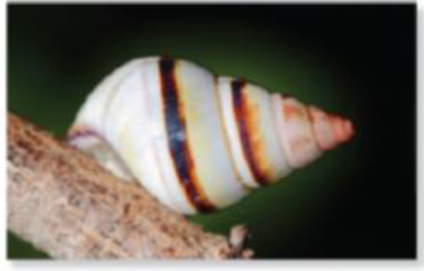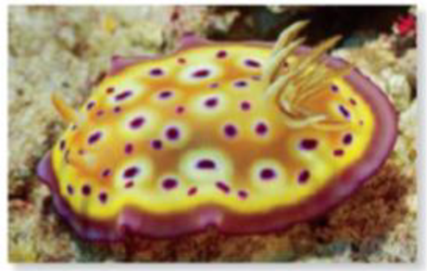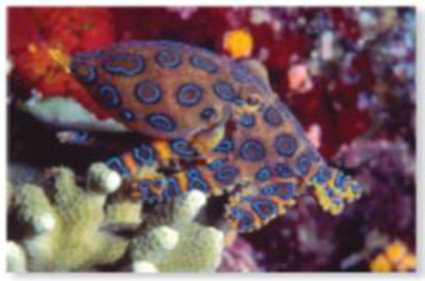
Concept explainers

(a) A quahog clam, cless Bavalvia

(b) A chlton, class Polyplacophora

(c) A snail, class Gastropoda

(d) A nudbranch, class Gastropoda

(e) A blue-ringed octopus, class Cephalopodan
Figure 34.12 Mollusks. (a) A bivalve shell, class Bivalvia, with growth rings. This quahog clam (Mercenaria mercenaria) can live over 20 years. (b) A chiton (Tonicella lineata), a polyplacophoran with a shell made up of eight separate plates. (c) A gastropod, the tree snail, Liguus fasciatus, from the Florida Everglades showing its characteristic coiled shell. (d) A nudibranch (Phyllidia ocellata). The nudibranchs are a gastropod subclass whose members have lost their shell altogether. (e) The highly poisonous blue-ringed octopus (Hapalochlaena lunulata), a cephalopod.
Core Skill: Connections Refer back to Figure 34.12. Which types of antipredator adaptations are possessed by mollusks?
Want to see the full answer?
Check out a sample textbook solution
Chapter 57 Solutions
Biology
- While collecting specimens, a marine biologist finds a sessile Cnidarian. The medusas that bud from it swim by contracting a ring of muscle in their bells. To which class does this specimen belong? Class Hydrozoa Class Cubozoa Class Scyphozoa Class Anthozoaarrow_forwardTrilobites (a) were early mollusks (b) are onychophorans (c) are characterized by parapodia and setae (d) were early arthropods (e) are an evolutionary link between annelids and arthropodsarrow_forwardWhich of the following statements is true? --Sea stars are dioecious possess dermal branchiae and they have two stomachs --Actinoptergians are fleshy/lobe finned with cycloid scales and a swim bladder --Ophiuroidea have bilateral larvae, and Aristotle's lantern and five arms --Sand dollars are echinoderms with long spines, gills, and pentaradial larvae --Sharks have an operculum, cosmoid scales and eyelidsarrow_forward
- 1-true tissues or not- who does not have? 2- radiate/bilateria- who for sure is in radiate? 3- diploblastic vs triploblastic- what does this mean? Who are diploblasts? 4- ecdysozoans & lophotrochozoans- they are all protostomes. What do the words mean? Give examples for each.arrow_forwardThe flexibility inherent in a segmented body plan was clearly important to crustacean evolution, but why are crustaceans so much more diverse than annelids, another segmented taxon?arrow_forwardBrachiopods superficially resemble bivalve molluscs, such as clams. How would you explain the differences in symmetry and internal structure to a layperson?arrow_forward
- Compare and contrast the hydraulic skeleton of molluscs with the hydrostatic skeletons of cnidarians and pseudocoelomates.arrow_forwardCephalopods are active marine predators, and many molluscan features are modified to fulfill their niche. Explain how each molluscan feature is modified, compared to gastropod and bivalve body plans. 1) Molluscan foot 2) Excurrent Siphon 3) Shell 4) Sensory organs and brainarrow_forwardSerial segmentation is a key characteristic of which of the following phyla? a. Mollusca b. Brachiopoda c. Bryozoa d. Annelidaarrow_forward
- All mollusks have a muscular foot, mantle and visceral mass. Look for these structures and compare them between the representative marine bivalve and terrestrial gastropod. Relate how these differences fit their lifestyle.arrow_forwardCompare and contrast the anatomical organizationof sponges and cnidarians. How do these differencesshape their functional biology, especially feeding mode?arrow_forwardWhat characteristic is common to the flatworms, molluscs, and annelids? a. All have bilateral symmetry. b. All are acoelomates. c. All are parazoans.d. All are vertebrates.arrow_forward
 Biology 2eBiologyISBN:9781947172517Author:Matthew Douglas, Jung Choi, Mary Ann ClarkPublisher:OpenStax
Biology 2eBiologyISBN:9781947172517Author:Matthew Douglas, Jung Choi, Mary Ann ClarkPublisher:OpenStax Biology (MindTap Course List)BiologyISBN:9781337392938Author:Eldra Solomon, Charles Martin, Diana W. Martin, Linda R. BergPublisher:Cengage Learning
Biology (MindTap Course List)BiologyISBN:9781337392938Author:Eldra Solomon, Charles Martin, Diana W. Martin, Linda R. BergPublisher:Cengage Learning Biology: The Dynamic Science (MindTap Course List)BiologyISBN:9781305389892Author:Peter J. Russell, Paul E. Hertz, Beverly McMillanPublisher:Cengage Learning
Biology: The Dynamic Science (MindTap Course List)BiologyISBN:9781305389892Author:Peter J. Russell, Paul E. Hertz, Beverly McMillanPublisher:Cengage Learning



